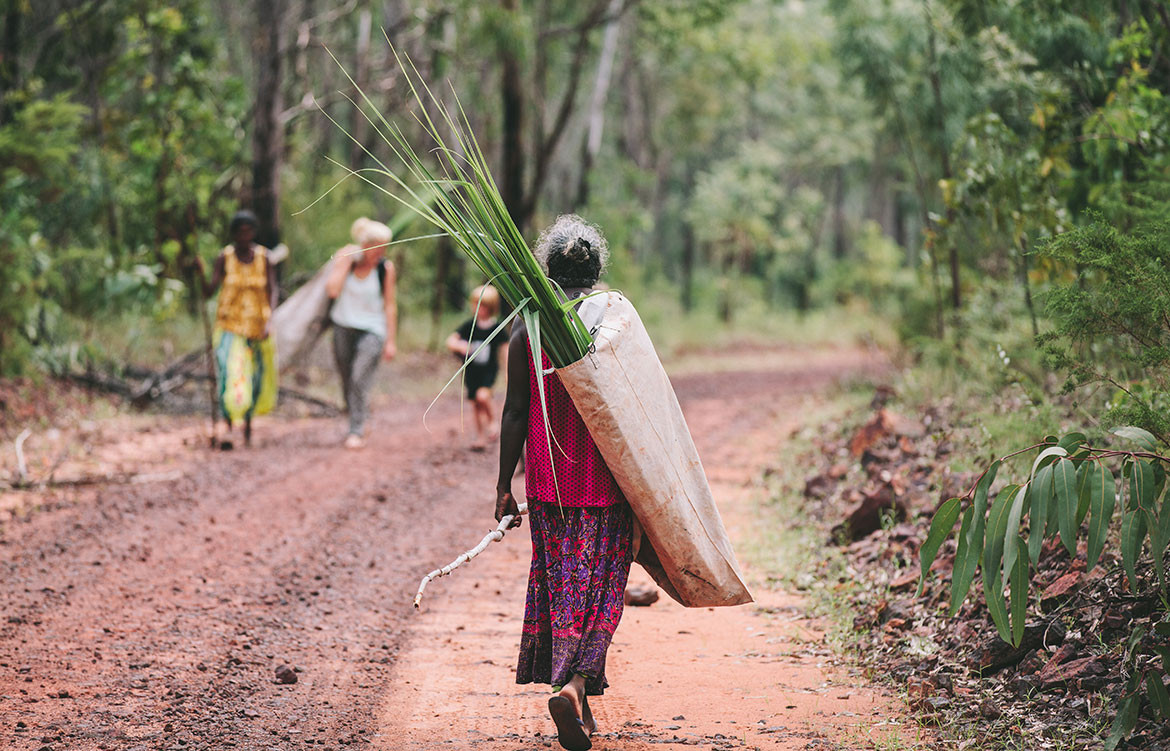What is the collaborative project?
Sasha Titchkosky: The foundations of Yuta Badayala (‘in a new light) is a range of lighting products we’ve developed with the artists. This has extended into beautiful sculptural wall art (for Noma’s pop-up restaurant in Sydney, for example) and meeting pods.
How did the project come about?
ST: We came across Yolngu weaving in about 2006 and embarked on a nearly 3-year journey of understanding this craft form, what went into it and the cultural significance it represents. Finally, after much questioning, I eventually asked Elcho what they thought and the uber-talented Mavis Ganambarr tried it. She is an incredible woman, as well as artist and senior cultural figure, whose talents are extraordinary. Once Mavis was keen to work on the project and didn’t see a problem with it, the magic began! [The project launched officially in 2009]. We have visited Elcho many times since and use these opportunities to develop new ideas.
What has been gained or learned as part of the process so far?
ST: We’ve been lucky enough to learn something of Yolngu culture and to develop deep and lasting friendships that traverse very different cultures and backgrounds.

What have been the challenges?
ST: The hardest part has been the revolving door at the Art Centre. The women have been incredible at keeping the project going despite constant change in Art Centre Managers. I feel as though we could have had a greater impact and developed more ideas if this role was more stable — we need this role to help drive the administrative side of the project and to help keep the quality evolving.
How does the collaboration work in terms of the creative process?
JM: I have always done weaving. We go out bush and get pandanas, dig up colours (plant roots) and make things with them. I mix the colours with rainwater and ash to dye the pandanas. I have always done it with my family, and now I do it with my daughter and grand-daughters. I am passing my weaving on. I have three grandchildren — A, B, C. Abigail, Bronwyn and now Cliff. They sit next to me when I weave; A, B, C, all in a row. They watch me and I teach them. I tell them about how to make the colours and do the weaving. Their ngandi (mum), Sharon, is my daughter, and she weaves with me too.
I used to only weave baskets and bags and mats things done from the old days and from the Mission days. But now we do new things. I weave in the old way to create new things like lampshades and soft sculpture — things like fish, dugong, puddy git (pussy cat) and piggy piggy.
ST: It’s a genuine collaboration. Koskela develops the form and the artists have complete artistic license to weave whatever they’d like on the frames. Every time we get a shipment it’s like Christmas as we unwrap the shades that have travelled from a remote island off the east coast of Arnhem Land and discover what they’ve created.

Why did you decide to start the project?
ST: When Russel and I started Koskela in 2000, we had always set out to create a business that did more than just make money. These projects with Indigenous artists are at the core of Koskela and are what drives us. 1% of our revenue now goes into the further development of these projects, as we’d like to be able to create more income-earning opportunities for these artists around Australia.
When we embarked on this project we very much wanted it to be structured in a way that meant it would be able to continue for as long as the artists were willing to work on it. It’s all self-funded, which means it’s not reliant on government grants or donations to continue. It was important to me that this wasn’t a short-term project.

Why is it important or beneficial to engage in collaborative projects like these?
JM: Making new things shows people our old ways. They can see our culture in a new light. Since I have been doing the new djama (work) people have started to say that I am manymuk (good) artist. My djama has been in exhibitions — I have been able to travel and my djama is in major galleries, like in the National Gallery of Australia in Canberra. My grandchildren will go there one day to see the things I created with them at my side.
The Yuta Badayala project is dhapirrk (fantastic) djama. We do special djama with Koskela. We do it with Sasha and Russel and Andres and Mika. They have new ideas and share them with us, and we share our ideas and culture with them. The Koskelas are manymuk family. My family is working with their family, creating new things, sharing culture, showing a new way. It also helps us earn extra rupiah (money) to raise up our kids. I feel like I will work with them until die. My family and their family working together.”
ST: It’s important to be able to use your skills to create positive change. It’s also a real honor to be able to learn and work with these artists and to have the privilege of learning something about the oldest surviving culture in the world.
The Yutu Badayala pieces are available for sale through Koskela, who buy all the work produced in the collaboration, eliminating the risk for the artists and the art centre, and then on-sell them to discerning consumers.
Photography courtesy of Koskela and Elcho Island Arts



